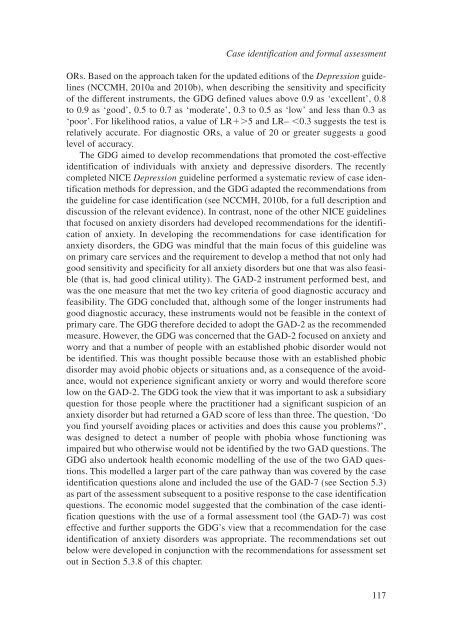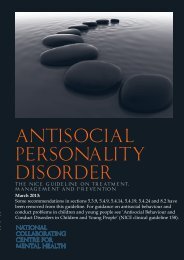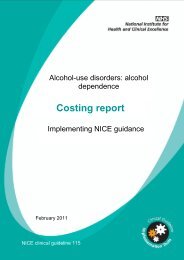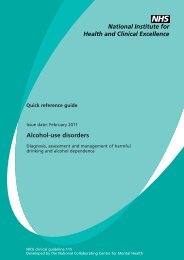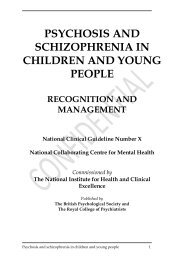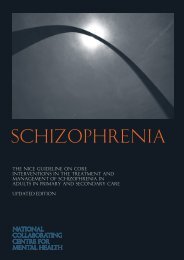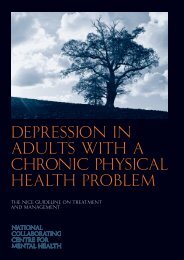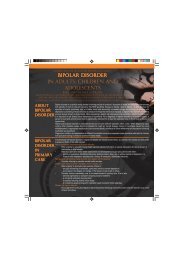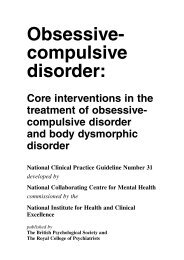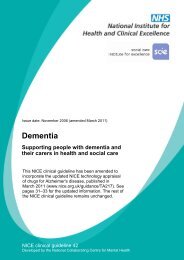CG123 Common mental health disorders - National Institute for ...
CG123 Common mental health disorders - National Institute for ...
CG123 Common mental health disorders - National Institute for ...
You also want an ePaper? Increase the reach of your titles
YUMPU automatically turns print PDFs into web optimized ePapers that Google loves.
Case identification and <strong>for</strong>mal assessmentORs. Based on the approach taken <strong>for</strong> the updated editions of the Depression guidelines(NCCMH, 2010a and 2010b), when describing the sensitivity and specificityof the different instruments, the GDG defined values above 0.9 as ‘excellent’, 0.8to 0.9 as ‘good’, 0.5 to 0.7 as ‘moderate’, 0.3 to 0.5 as ‘low’ and less than 0.3 as‘poor’. For likelihood ratios, a value of LR5 and LR– 0.3 suggests the test isrelatively accurate. For diagnostic ORs, a value of 20 or greater suggests a goodlevel of accuracy.The GDG aimed to develop recommendations that promoted the cost-effectiveidentification of individuals with anxiety and depressive <strong>disorders</strong>. The recentlycompleted NICE Depression guideline per<strong>for</strong>med a systematic review of case identificationmethods <strong>for</strong> depression, and the GDG adapted the recommendations fromthe guideline <strong>for</strong> case identification (see NCCMH, 2010b, <strong>for</strong> a full description anddiscussion of the relevant evidence). In contrast, none of the other NICE guidelinesthat focused on anxiety <strong>disorders</strong> had developed recommendations <strong>for</strong> the identificationof anxiety. In developing the recommendations <strong>for</strong> case identification <strong>for</strong>anxiety <strong>disorders</strong>, the GDG was mindful that the main focus of this guideline wason primary care services and the requirement to develop a method that not only hadgood sensitivity and specificity <strong>for</strong> all anxiety <strong>disorders</strong> but one that was also feasible(that is, had good clinical utility). The GAD-2 instrument per<strong>for</strong>med best, andwas the one measure that met the two key criteria of good diagnostic accuracy andfeasibility. The GDG concluded that, although some of the longer instruments hadgood diagnostic accuracy, these instruments would not be feasible in the context ofprimary care. The GDG there<strong>for</strong>e decided to adopt the GAD-2 as the recommendedmeasure. However, the GDG was concerned that the GAD-2 focused on anxiety andworry and that a number of people with an established phobic disorder would notbe identified. This was thought possible because those with an established phobicdisorder may avoid phobic objects or situations and, as a consequence of the avoidance,would not experience significant anxiety or worry and would there<strong>for</strong>e scorelow on the GAD-2. The GDG took the view that it was important to ask a subsidiaryquestion <strong>for</strong> those people where the practitioner had a significant suspicion of ananxiety disorder but had returned a GAD score of less than three. The question, ‘Doyou find yourself avoiding places or activities and does this cause you problems?’,was designed to detect a number of people with phobia whose functioning wasimpaired but who otherwise would not be identified by the two GAD questions. TheGDG also undertook <strong>health</strong> economic modelling of the use of the two GAD questions.This modelled a larger part of the care pathway than was covered by the caseidentification questions alone and included the use of the GAD-7 (see Section 5.3)as part of the assessment subsequent to a positive response to the case identificationquestions. The economic model suggested that the combination of the case identificationquestions with the use of a <strong>for</strong>mal assessment tool (the GAD-7) was costeffective and further supports the GDG’s view that a recommendation <strong>for</strong> the caseidentification of anxiety <strong>disorders</strong> was appropriate. The recommendations set outbelow were developed in conjunction with the recommendations <strong>for</strong> assessment setout in Section 5.3.8 of this chapter.117


